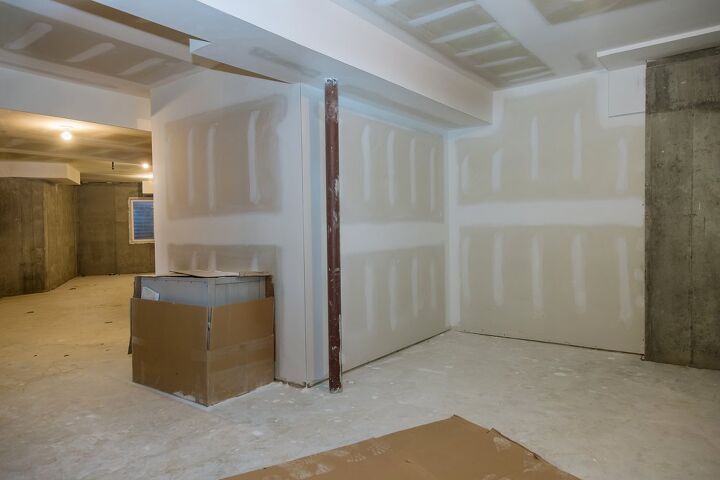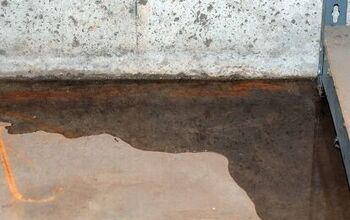How To Straighten Basement Walls Yourself (Do This!)

We build our lives in our homes, and often our home is the greatest asset we own. Unfortunately, problems with the basement walls and foundation can put our home in jeopardy. A bowed basement wall is a big concern and one that should be addressed immediately to protect your home and investment. Fixing a bowed basement wall can be a DIY project, pending you have a minimal amount of bowing.
It is possible to straighten a bowed basement wall yourself as long as the wall is less than two inches out of alignment. Both hydraulic cement and carbon fiber strapping can be used to help straighten a basement wall yourself. Both solutions can solve cracks and bows due to moisture penetration and house settlement.
Unfortunately, if your wall is bowed more than two inches, you will most likely have to consult a professional. Walls that are bowed between two and four inches may require steel beams and anchoring systems. Walls that are bowed further than four inches may have to be rebuilt to maintain your home’s structure and strength.
Do You Need Handyman Services?
Get free, zero-commitment quotes from pro contractors near you.

What Causes Basement Walls to Bow?
Often, the basement walls are part of your home’s integral foundation and help give your home support, strength, and structure. Bowing walls in a basement can come from several sources, all of which are problematic and can cause further damage to your home. Usually, bowed walls are caused by one of three reasons:
- Water – While we need water to survive, it is a highly damaging and corrosive element. Water can cause cracks and bowing to form in your basement wall. Most of the time, water damage is caused by poor drainage around your home. This drainage can create hydrostatic pressure that pushes on the outside of the basement wall. Usually, water damage shows up as zigzag cracks along your basement wall.
- Settling – As a house sinks into the soil on which it is built atop, a home can begin to settle. This process is typical for houses, but sometimes too much movement and settling can cause cracks to form in the foundation and the basement walls. Usually, settlement cracks will show up as vertical cracks that span the height of the wall.
- Lateral Pressure – When the outside of your basement wall experiences lateral pressure, it can force the basement wall outward, bowing at the center. Outward pressure can come from water pressure or expansive soil. Sometimes the soil is superabsorbent, causing it to expand and press outward. Further, frozen ground can cause the soil to expand, pressing onto your basement wall.
How Do I Measure a Bowed Wall?
Trying to determine how bad the bow is in your wall will help you decide which corrective action to take. To measure how bowed your basement wall is, you will need to:
Step 1: Determine The Widest Point
Look at your bowed wall and determine which point is furthest bowed. This point is the widest point of the bow and is usually, but not always, located in the middle of the wall.
Step 2: Mark Plumb Line
Next, take a string with a weight attached to the end. Hold the string so that it just barely touches the widest part of the bow. Mark the point the weighted plumb line falls to on the floor.
Step 3: Measure
Measure the mark you made on the floor, denoting the furthest part of the bowed wall to the edge of the wall at the most narrow point on the wall. The distance between the two will be how far out of alignment your wall is. Serious work and reconstruction will usually begin when your wall is out of alignment by 3.5 to 4 inches.
How To Repair Walls
Repairing the walls yourself is an excellent option for a savvy DIY-er. Straightening a bowed basement wall yourself is suitable if your wall is bowed less than 2 inches. To repair your basement walls, you have two DIY options.
Option 1: Hydraulic Cement
Using hydraulic cement is best used when the wall has slight cracking or if the wall is bowing inward. This type of damage can be caused by moisture damage or from house settlement cracks.
Step 2: Prepare WallRemove any cracking, crumbling, and loose pieces of the wall before you start. You can use a stiff wire brush to clean and prepare the wall’s surface.
Step 3: Mix CementFollowing the manufacturer’s instructions, mix the hydraulic cement. It is important to maintain a suitable temperature while working with this material. Usually, a temperature range of 45 degrees F and 90 degrees F is acceptable.
Step 4: Apply CementOnce the cement is mixed, apply the cement to the cracks beginning at the top of the wall and moving your way down. Be sure to use firm and constant pressure throughout the application to ensure the cement is packed into place. Not only will the cement help to restore the wall’s strength, but if properly applied, it can help eliminate moisture leaks into your wall.
Option 2: Carbon Fiber Straps
Examine the wall and determine if your wall warrants using carbon fiber strips. This material can add strength to your wall if it has suffered bowing caused by water damage or house settlement. Carbon fiber straps will repair a bowed wall that is up to 2 inches out of alignment.
Step 2: Plan SpacingCarbon fiber strips must be placed every 48 inches along the wall to give the bowed wall the strength it needs. Measure your wall and determine the appropriate spacing before starting the application.
Step 3: Install Sill PlateTo give the carbon fiber strips something to adhere to, you must install a sill plate. These are installed by drilling a footing along the wall and installing the plates every 48 inches.
Step 4: Attach Carbon FiberNext, attach the carbon fiber strips to the wall by mounting each strip to the sill brackets. The carbon fiber is covered with epoxy along the foundation wall to anchor the strips firmly in place. The strips will work to keep the bowed wall in place, preventing further damage.
When Should I Call a Professional?
Unfortunately, sometimes a basement wall is bowed too far, and it is out of the range of what a homeowner can safely and effectively accomplish alone. If your basement wall is bowed more than two inches out of alignment, it is time to call a professional to help restore the structure and needed rigidity to your wall. A professional will have two options to help bring your wall back into alignment.
- Anchors – Using wall anchors can help straighten a wall that has bowed. This method will not only help to bring a wall back into alignment, but it will give your house the additional needed support. A wall anchor is a system of two steel plates that are connected with a steel shaft. One plate attaches to the inside of your basement wall, and the other steel plate is buried in your yard. The steel shaft connects the two plates and can be tightened with a large bolt, gradually pulling your wall back into alignment.
- Beams – As a more industrial response to the carbon fiber strips, metal beams can perform the same type of work but with more strength. Metal beams are usually the solution when a wall anchoring system does not work due to property lines, tree roots, or sidewalks. The metal beam is inserted into a special brace that attaches to the wall. The brace is slowly tightened, pushing the wall back into alignment. After the wall has been straightened again, cracks can be repaired and sealed to prevent moisture from entering the home.
Do You Need Handyman Services?
Get free, zero-commitment quotes from pro contractors near you.

Related Questions
Are Bowed Basement Walls Dangerous?
Bowed walls, especially in your basement or garage, can spell real trouble for your house. The main concern with any bowed wall is the structural integrity of your home. If bowed walls are left for too long, they can eventually lose their strength, causing catastrophic cave-ins. This impact could affect your entire home.Aside from structural damage, a bowed wall can introduce cracks into your home. These cracks can allow moisture to enter your home, which can lead to leaks and mold.Cracks are also an open invitation for pests and insects to enter your home, causing an infestation. Further, cracked and bowing basement walls can impact other structural elements in your home. A bowed basement wall can cause your flooring to become uneven or gaps to show around your doors and windows.
When Is it Time To Rebuild Your Basement Wall?
Sometimes, a bowed wall in the basement is beyond repair and cannot be corrected with traditional methods. Usually, if there is more than a 2-inch bow in your wall, the wall is beyond the point of repair for DIY methods. Hydraulic cement and carbon fiber strapping have some limitations and will not pull a wall together that is more than 2 inches out of alignment. Using anchoring and beams, you may be able to help correct the wall up to a 4-inch bow.Anything beyond a 4-inch bow will be beyond the ability of beams and wall anchors. If your wall is severely bowed, it will be time to rebuild the wall. Plan for plenty of time for the repair, as rebuilding a basement wall is a technical and lengthy process.Rebuilding a basement wall involves rebuilding much of your home’s foundation and can be pretty costly. It is always best to try alternative bracing and anchoring systems before your bowed wall goes beyond the point of repair.
More Related Guides

We are a team of passionate homeowners, home improvement pros, and DIY enthusiasts who enjoy sharing home improvement, housekeeping, decorating, and more with other homeowners! Whether you're looking for a step-by-step guide on fixing an appliance or the cost of installing a fence, we've here to help.
More by Upgraded Home Team













![The 10 Best Table Saws - [2022 Reviews & Buyer's Guide]](https://cdn-fastly.upgradedhome.com/media/2023/07/31/9070645/the-10-best-table-saws-2022-reviews-buyer-s-guide.jpg?size=350x220)













